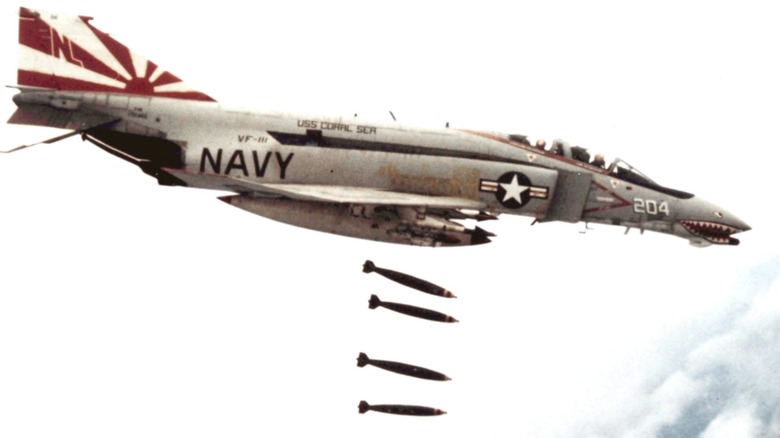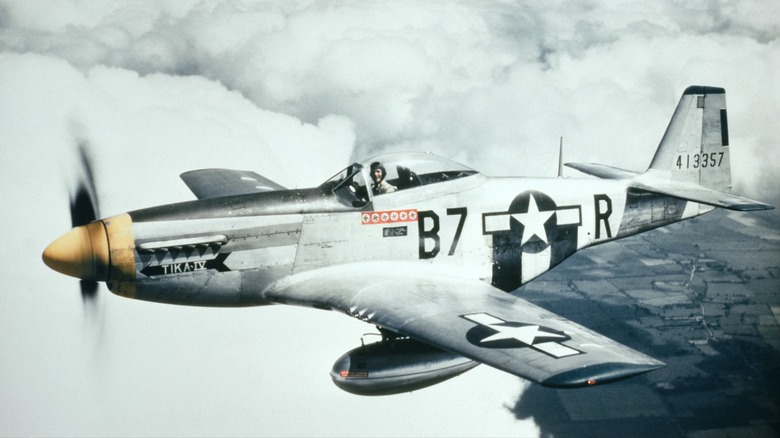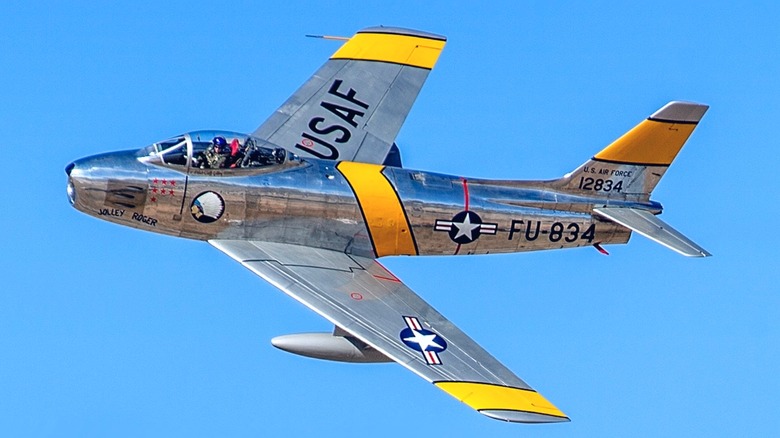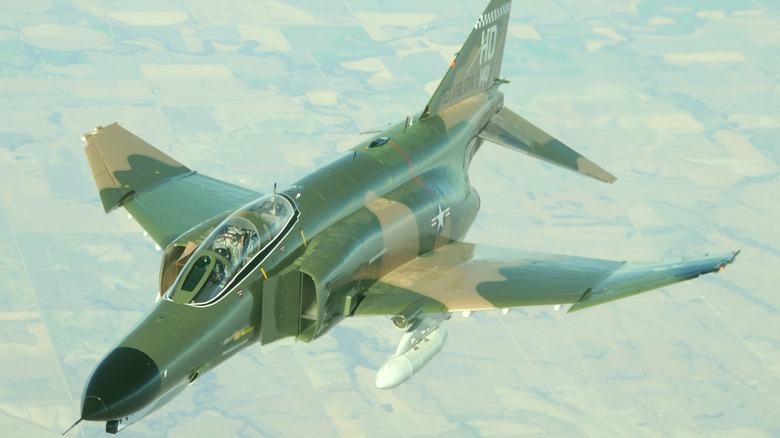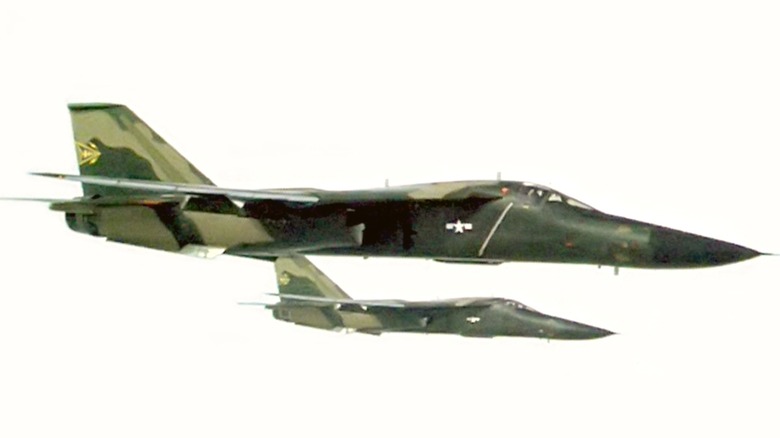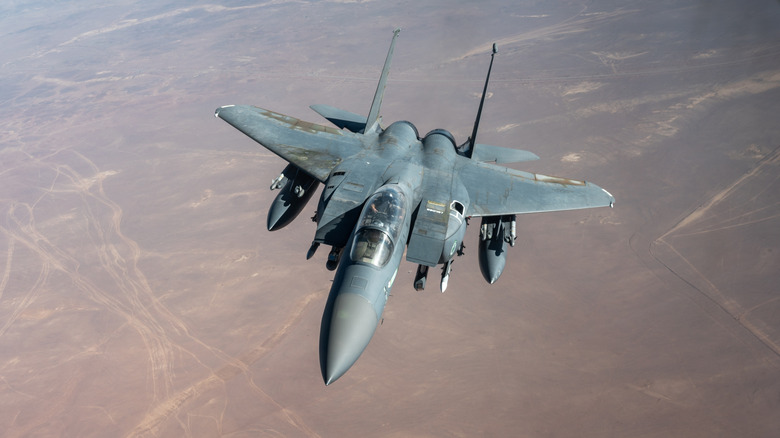America's Deadliest Aircraft From Every Aerial War
The United States has been at the forefront of aircraft development for more than a century, and with innovation driving growth through each new conflict, resulting in impressive military machines. The U.S. only fielded one aircraft, the DH-4, during WWI, but in each subsequent campaign, massive fleets of fighters and bombers rained destruction down onto U.S. enemies. Each conflict has one impressive aircraft that's deadlier than the rest.
When it comes to determining which U.S. aircraft was the deadliest in a given conflict, several factors have to be considered. For instance, one could make the case that the Enola Gay was the deadliest aircraft of WWII because it single-handedly ended the lives of 140,000 people on a single mission. That has less to do with Boeing's impressive B-29 Superfortress and more to do with the atomic bomb. Alternately, is an aircraft deadly because it wins in air combat the most or because a plane destroys more objects on the ground?
This article took several aspects into account, including air-to-air success, air-to-ground capabilities, and the overall combat record of wins and losses. Bombers are a bit tricky, given how they were used throughout the 20th century. So, the only aircraft examined here are fighter aircraft. Still, each of these planes set the standard for American air superiority, defeating a variety of enemies in austere environments.
WWII - P-51 Mustang
There was a great deal of innovation during World War II, leading to the creation of numerous nascent technologies, including jet engines. While some fighter planes flew toward the end of the war, the United States' greatest asset was the North American P-51 Mustang. This aircraft entered service in 1942 for the Royal Air Force before becoming a mainstay of American aviation. In that capacity, the P-51 became a legend, having taken down thousands of enemy aircraft during WWII.
Throughout its time in service, more than 15,000 P-51s were built, and there were several variants. Numerous outfits used the P-51 during the war, including the venerated Tuskegee Airmen. In Europe, P-51s were used primarily as bomber escorts, where they destroyed nearly 5,000 enemy aircraft. A P-51 could carry 2,000 pounds of bombs or 10 five-inch rockets, as well as six .50 caliber machine guns. It packed a punch, to say the least.
When the war ended, things changed for the P-51. Jets gradually became the norm, and while some P-51s were used in the Korean War, they were secondary to more advanced fighter jets and attack aircraft. The P-51 remained in service, primarily with the Reserve and Air National Guard, until 1957, when they were phased out of the inventory. You can find them all over the country in various museums today, as many survived their service.
Korea - F-86 Sabre
When the Korean War kicked off in 1950, the United States had a fighter jet ready and waiting. The North American F-86 Sabre was the nation's first swept-wing fighter, and its deadliest fighter from the conflict. Designed for dogfighting, the Sabre proved more than capable against the MiG-15, returning them to the ground ... hard. It's one of the earliest fighters to engage in jet-on-jet combat. The F-86's success earned it an extended initial order, and by the end of its time in service, more than 9,500 were produced.
The aircraft's design was inspired by captured German data from WWII that showed air compressibility was delayed with swept wings, providing pilots with better control at high subsonic speeds compared to straight-wing aircraft. An estimated 224 F-86s were lost in combat, with around 100 being taken out in aerial combat. The MiG-15, on the other hand, lost 765 to the Sabre.
Part of why the F-86 was so successful had to do with American pilots, many of whom were WWII veterans. Their combat experience helped establish a fighting force that was battle-tested and highly capable. Going up against Chinese and North Korean pilots who had limited experience likely worked in the Americans' favor. Still, the F-86 was a fantastic aircraft with exceptional dogfighting capabilities that ensured it dominated the skies over Korea during the conflict. As the 1950s progressed, the U.S. moved away from the F-86, but it continued to fly for several nations for many years.
Vietnam - F-4 Phantom II
The Vietnam War was a long, drawn-out conflict that saw American pilots go up against a variety of aircraft with improved capabilities. While the U.S. had a number of successful planes for the fight, the deadliest was the excellent McDonnell Douglas F-4 Phantom II. It entered service in 1960 and had over 5,200 produced by 1978. The F-4 performed multiple roles in Vietnam, serving as a supersonic interceptor that also functioned as a fighter and bomber, so it had a lot going for it.
It packed much into its large airframe, including two General Electric J-79-GE-15 engines that give it a top speed of Mach 2.23 (1,711 mph). It could carry an armament (nuclear or conventional) of up to 16,000 pounds, including air-to-ground and air-to-air missiles, and bombs. When the war began, the U.S. Air Force, Navy, and Marine Corps operated the F-4 primarily as an air superiority fighter, but its role expanded as the conflict progressed, including aerial reconnaissance.
The Vietnam War saw five Americans become aces, which means they shot down five or more enemy aircraft in a dogfight. Every one of the aces flew a version of the F-4 Phantom II, and it was hardly the only plane operated by the U.S. during the war. The F-4 continued flying long after Vietnam, serving nearly a dozen countries. It was finally retired in 1997, though recently, old F-4s gained a new function as remote-controlled target drones, designated QF-4.
Operation Desert Storm - F-111 Aardvark
Most people familiar with Operation Desert Storm likely consider the F-15 Eagle to be the deadliest aircraft of the conflict. On the one hand, this is correct since F-15s were responsible for 34 of the 37 air-to-air victories against Iraqi forces. While it was certainly a deadly aircraft and one of the most successful of all time, having never been shot down in aerial combat, the F-15 isn't the deadliest U.S. aircraft of the Gulf War.
That distinction belongs to the F-111 Aardvark, which was used extensively throughout the operation to strike all manner of targets. The F-111 Aardvark was first introduced in the 1960s and was a beast during the Vietnam War when it flew around 4,000 combat sorties and only lost six planes. In Desert Storm, the aircraft was heavily utilized for ground strike missions. During the war, F-111s destroyed more tanks on the ground than the venerated A-10 Warthog, an aircraft designed for that purpose.
F-111s destroyed more than 1,500 armored vehicles, while the A-10 took out around 900. In the opening days of the Gulf War, 110 F-111s flew around 5,000 sorties, operating mostly as a bomber and attack aircraft. They primarily flew at night, wreaking havoc on the Iraqi military throughout the war. The F-111 continued to fly long after the war ended, its service not coming to an end until 2010 for the Australians. The pilots from down under dubbed the aircraft the "Pig."
War on Terror - F-15 Eagle
The War on Terror is an ill-defined conflict that includes combat operations throughout Iraq and Afghanistan, during the first two decades of the 21st century. Other locations in the Middle East and multiple belligerents make it difficult to determine the deadliest aircraft. There are two notable contenders. While the F/A-18 is a deadly war machine, the F-15E Strike Eagle holds a better combat record and was used more extensively in both air-to-air and bombing missions in multiple locations.
The F-15 is an incredible all-weather tactical fighter that was designed to gain air superiority in a hostile area. It's done this in multiple conflicts, and it was one of the most-used aircraft of the War on Terror. The first time an F-15 took to the skies for the U.S. Air Force was in 1976, so the model used in the 21st century is an improved variant. The F-15E Strike Eagle entered the inventory in 1988, and it didn't take long to prove itself a superior combat aircraft.
F-15Es flew throughout Operation Iraqi Freedom and Operation Enduring Freedom in Afghanistan. These highly versatile aircraft excel in numerous areas, with the platform's kill ratio of 104-0 making it the deadliest aircraft for air-to-air combat when you take into account aircraft losses. Decades after its introduction, the F-15 remains a lethal aircraft that continues to operate and receive upgrades, ensuring it remains as relevant as the newer F-15EX Eagle II, which was introduced in 2024.
